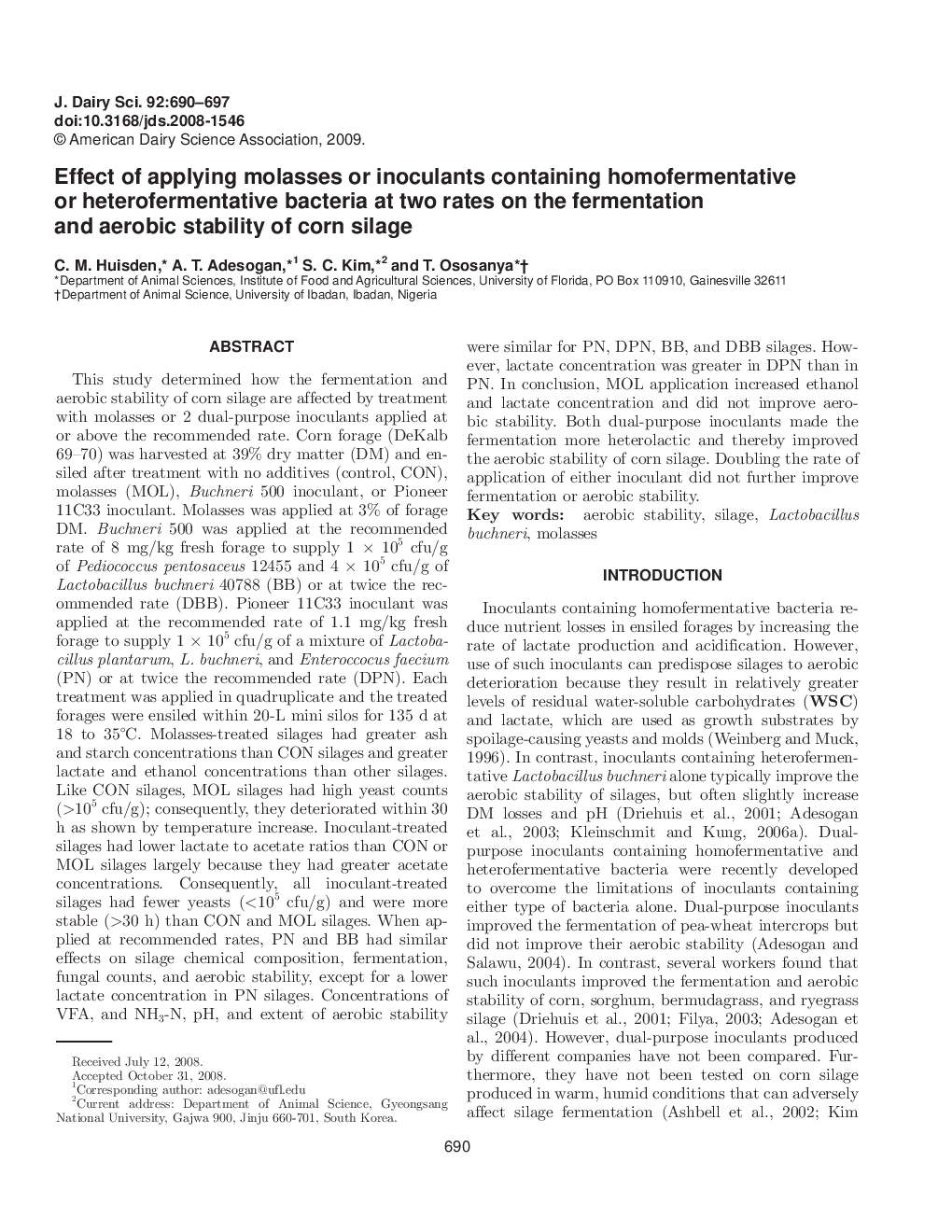| کد مقاله | کد نشریه | سال انتشار | مقاله انگلیسی | نسخه تمام متن |
|---|---|---|---|---|
| 2439417 | 1108096 | 2009 | 8 صفحه PDF | دانلود رایگان |
عنوان انگلیسی مقاله ISI
Effect of applying molasses or inoculants containing homofermentative or heterofermentative bacteria at two rates on the fermentation and aerobic stability of corn silage
دانلود مقاله + سفارش ترجمه
دانلود مقاله ISI انگلیسی
رایگان برای ایرانیان
موضوعات مرتبط
علوم زیستی و بیوفناوری
علوم کشاورزی و بیولوژیک
علوم دامی و جانورشناسی
پیش نمایش صفحه اول مقاله

چکیده انگلیسی
This study determined how the fermentation and aerobic stability of corn silage are affected by treatment with molasses or 2 dual-purpose inoculants applied at or above the recommended rate. Corn forage (DeKalb 69-70) was harvested at 39% dry matter (DM) and ensiled after treatment with no additives (control, CON), molasses (MOL), Buchneri 500 inoculant, or Pioneer 11C33 inoculant. Molasses was applied at 3% of forage DM. Buchneri 500 was applied at the recommended rate of 8 mg/kg fresh forage to supply 1 Ã 105 cfu/g of Pediococcus pentosaceus 12455 and 4 Ã 105 cfu/g of Lactobacillus buchneri 40788 (BB) or at twice the recommended rate (DBB). Pioneer 11C33 inoculant was applied at the recommended rate of 1.1 mg/kg fresh forage to supply 1 Ã 105 cfu/g of a mixture of Lactobacillus plantarum, L. buchneri, and Enteroccocus faecium (PN) or at twice the recommended rate (DPN). Each treatment was applied in quadruplicate and the treated forages were ensiled within 20-L mini silos for 135 d at 18 to 35°C. Molasses-treated silages had greater ash and starch concentrations than CON silages and greater lactate and ethanol concentrations than other silages. Like CON silages, MOL silages had high yeast counts (>105 cfu/g); consequently, they deteriorated within 30 h as shown by temperature increase. Inoculant-treated silages had lower lactate to acetate ratios than CON or MOL silages largely because they had greater acetate concentrations. Consequently, all inoculant-treated silages had fewer yeasts (<105 cfu/g) and were more stable (>30 h) than CON and MOL silages. When applied at recommended rates, PN and BB had similar effects on silage chemical composition, fermentation, fungal counts, and aerobic stability, except for a lower lactate concentration in PN silages. Concentrations of VFA, and NH3-N, pH, and extent of aerobic stability were similar for PN, DPN, BB, and DBB silages. However, lactate concentration was greater in DPN than in PN. In conclusion, MOL application increased ethanol and lactate concentration and did not improve aerobic stability. Both dual-purpose inoculants made the fermentation more heterolactic and thereby improved the aerobic stability of corn silage. Doubling the rate of application of either inoculant did not further improve fermentation or aerobic stability.
ناشر
Database: Elsevier - ScienceDirect (ساینس دایرکت)
Journal: Journal of Dairy Science - Volume 92, Issue 2, February 2009, Pages 690-697
Journal: Journal of Dairy Science - Volume 92, Issue 2, February 2009, Pages 690-697
نویسندگان
C.M. Huisden, A.T. Adesogan, S.C. Kim, T. Ososanya,